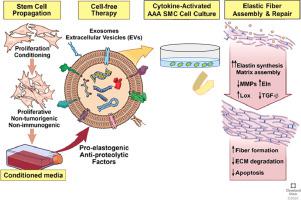Acta Biomaterialia ( IF 9.7 ) Pub Date : 2020-07-06 , DOI: 10.1016/j.actbio.2020.07.002 S Sajeesh 1 , Thomas Broekelman 2 , Robert P Mecham 2 , Anand Ramamurthi 3

|
Abdominal aortic aneurysms (AAA) are localized expansions of the abdominal aorta that develop due to chronic proteolytic disruption of the structural extracellular matrix (ECM) components (elastin and collagen) within the aorta wall. Major limitations in arresting or reversing AAAs lie in naturally poor and aberrant regeneration and repair of elastic matrix structures in the aorta wall. Bone marrow derived mesenchymal stem cells (BM-MSCs) have emerged as a promising regenerative tool and their therapeutic effects are also known to be effected through their paracrine secretions. Extracellular vesicles (EVs) present in these secretions have emerged as critical cellular component in facilitating many therapeutic benefits of MSCs. EV treatment is thus potentially appealing as a stem cell-inspired cell-free approach to avoid possible phenotypic plasticity of MSCs in vivo. In this study, we investigated the thus far unknown effects of BM-MSC derived EVs on vascular elastic matrix repair in the context of AAA treatment. EVs isolated from BM-MSC source were characterized and their pro-regenerative and their anti-proteolytic effects were evaluated on our established in vitro experimental conditions derived from AAA rat model. Our studies revealed the efficacy of BM-MSC derived EVs in attenuating the proteolytic activity and also in imparting elastic matrix regenerative benefits under aneurysmal environment. Interestingly, compared to cell culture conditioned media (CCM), EVs demonstrated superior regenerative and anti-proteolytic benefits in a proteolytic injury culture model of AAA. From these studies, it appears that EVs derived from BM-MSCs could be beneficial in undertaking a reparative effort in AAA induced degeneration of vascular tissue.
Statement of Significance
Abdominal aortic aneurysms (AAAs) are localized, rupture-prone expansions of the aorta which result from loss of wall flexibility due to enzymatic breakdown of elastic fibers. There are no established alternatives to surgery, which possess high risk for the mostly elderly patients. Our previous studies have established the elastic regenerative and reparative effect of cell culture secretions derived from adult stem cell source. In this study, we propose to isolate extracellular vesicles (exosomes) from these secretions and evaluate their regenerative benefits in AAA smooth muscle cell culture model. This simple and innovative treatment approach has the potential to arrest or reverse AAA growth to rupture, not possible so far.
中文翻译:

干细胞衍生的细胞外囊泡,用于血管弹性基质的再生修复。
腹主动脉瘤(AAA)是由于主动脉壁内结构性细胞外基质(ECM)成分(弹性蛋白和胶原蛋白)的慢性蛋白水解破坏而引起的腹主动脉局部扩张。阻止或逆转AAA的主要限制在于主动脉壁中自然缺乏弹性的异常再生和修复弹性基质结构。骨髓来源的间充质干细胞(BM-MSC)已经成为一种有前途的再生工具,其治疗作用也可通过其旁分泌而实现。这些分泌物中存在的细胞外囊泡(EVs)已成为促进MSC的许多治疗益处的关键细胞成分。因此,EV治疗可能会吸引人,因为它是一种不受干细胞启发的无细胞方法,可避免体内MSC可能的表型可塑性。在这项研究中,我们调查了迄今为止BM-MSC衍生的EV在AAA治疗中对血管弹性基质修复的未知影响。从BM-MSC来源分离的EV进行了表征,并在我们建立的源自AAA大鼠模型的体外实验条件下评估了它们的前再生和抗蛋白水解作用。我们的研究揭示了BM-MSC衍生的EV在降低动脉粥样硬化环境下蛋白水解活性以及赋予弹性基质再生效益方面的功效。有趣的是,与细胞培养条件培养基(CCM)相比,电动汽车在AAA的蛋白水解损伤培养模型中显示出优异的再生和抗蛋白水解作用。从这些研究看来,源自BM-MSC的EV在进行AAA诱导的血管组织变性的修复方面可能是有益的。
重要声明
腹主动脉瘤(AAAs)是由于弹性纤维的酶促降解导致壁柔韧性下降而导致的主动脉局部,易破裂扩张。目前尚无可替代的手术方法,因为手术对大多数老年患者具有高风险。我们以前的研究已经建立了源自成体干细胞来源的细胞培养物分泌物的弹性再生和修复作用。在这项研究中,我们建议从这些分泌物中分离细胞外囊泡(外泌体),并评估它们在AAA平滑肌细胞培养模型中的再生益处。这种简单而创新的治疗方法具有阻止或逆转AAA生长破裂的潜力,这是迄今为止尚不可能的。


























 京公网安备 11010802027423号
京公网安备 11010802027423号